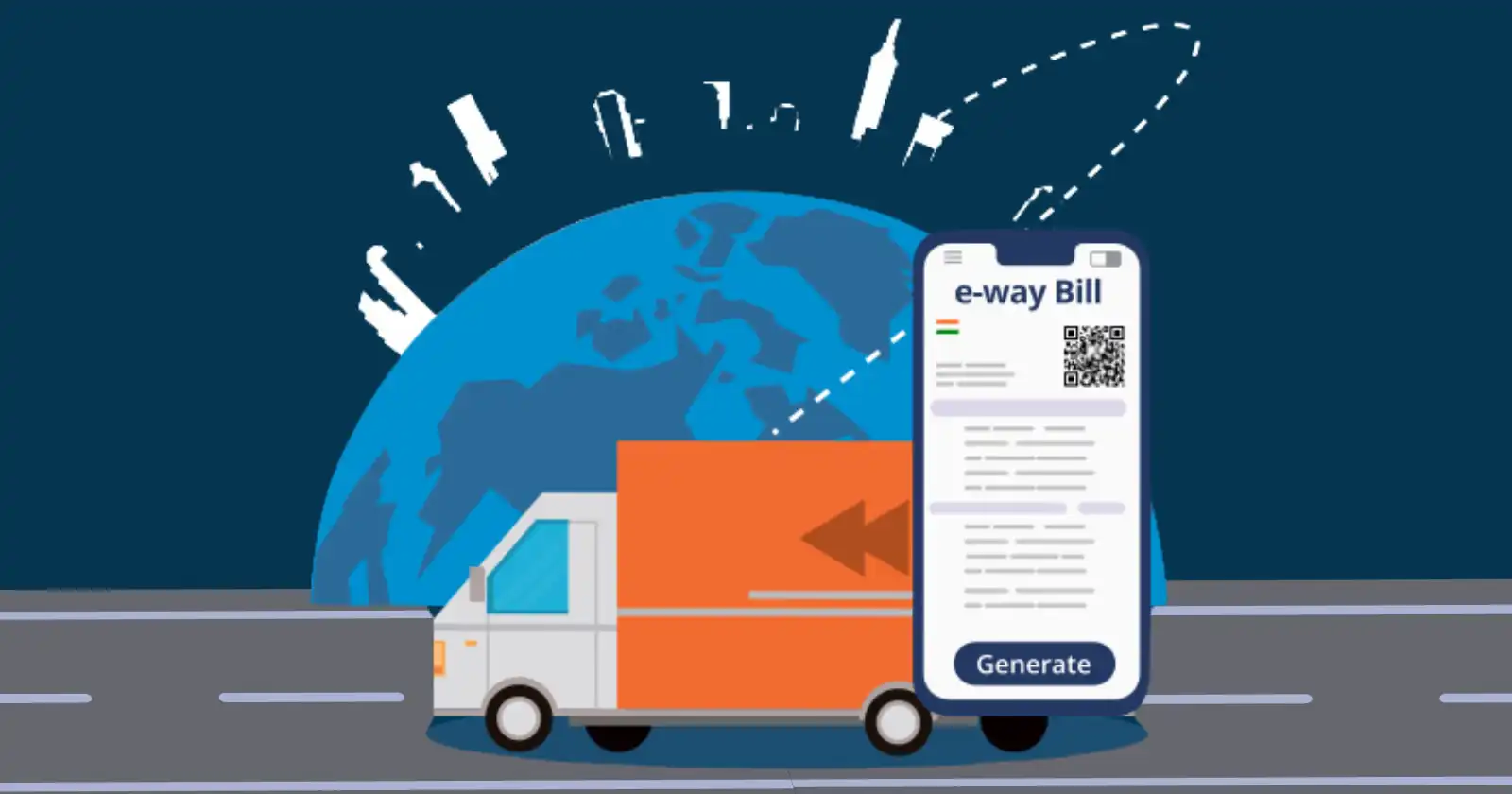Under the Goods and Services Tax (GST) regime, E-Way Bill is a required document. It is an essential part of the GST compliance framework and aims to bring transparency and efficiency to the transportation of goods.
What is the E-Way Bill?
The E-Way Bill, short for Electronic Way Bill, is a digital document that is required to be carried by a person transporting goods worth more than 50,000 rupees under Section 68 of the Goods and Services Tax Act. It is issued by the taxpayer or logistics company through the portal site called the E-Way Bill system ( https://ewaybillgst.gov.in/ ). Upon issuance, you will be issued with a unique electronic waybill number. It contains details about the movement of goods, such as the consignor, consignee, product details, and vehicle. It is proof that the goods that have been transported comply with the GST regulations.
When does E-Way need to be issued?
Issuance is required when transporting goods exceeding 50,000 rupees in the following cases:
- Supply of goods
- Supply for reasons other than the above (returns, etc.)
- Purchasing from GST non-registered vendors
- Supply of goods includes sale, transfer, and barter/exchange.
When it is not necessary to issue an E-Way Bill?
- Transport other than by car
- Transport for customs clearance within a port
- Transportation under customs jurisdiction
- Transshipment of cargo to or from Nepal and Bhutan
- Ministry of Defense-related transportation
- Forwarding empty containers after cargo transportation is completed
- Transportation to the scale (if there is a Delivery Challan)
- Railway transportation of government or authority cargo
- Transport of other excluded goods
Who Should Generate an e-Way Bill?
1. Registered Person:
– A registered person must generate an e-Way Bill when there is a movement of goods exceeding Rs 50,000 in value to or from them.
– Even if the value of goods is less than Rs 50,000, a registered person or transporter may choose to generate and carry an e-Way Bill.
2. Unregistered Persons:
– Unregistered persons are also required to generate an e-Way Bill.
– In the case of a supply from an unregistered person to a registered person, the receiver must ensure compliance as if they were the supplier.
3. Transporter:
– Transporters carrying goods by road, air, rail, etc., need to generate an e-Way Bill if the supplier has not generated one.
The transporters need not generate the Eway bill (as Form EWB-01 or EWB-02) where all the consignments in the conveyance :
- Individually(single Document**) is less than or equal to Rs 50,000 BUT
- In Aggregate (all documents** put together) exceeds Rs 50,000
Document means Tax Invoice/Delivery challan/Bill of supply
Unregistered Transporters will be issued Transporter ID on enrolling on the e-way bill portal after which Eway bills can be generated.
| Who | When | Part | Form |
|---|---|---|---|
| Every Registered person under GST | Before movement of goods | Fill Part A | Form GST EWB-01 |
| Registered person as consignor or consignee<br>(mode of transport may be owned or hired) OR is recipient of goods | Before movement of goods | Fill Part B | Form GST EWB-01 |
| Registered person as consignor or consignee<br>and goods are handed over to transporter of goods | Before movement of goods | Fill Part B | The registered person shall furnish the information relating to the transporter in Part B of FORM GST EWB-01 |
| Transporter of goods | Before movement of goods | Generate e-way bill on basis of information shared by the registered person in Part A of FORM GST EWB-01 | |
| An unregistered person under GST and recipient is registered | Compliance to be done by Recipient as if he is the Supplier. | 1. If the goods are transported for a distance of fifty kilometers or less, within the same State/Union territory from the place of business of the consignor to the place of business of the transporter for further transportation, the supplier or the transporter may not furnish the details of conveyance in Part B of FORM GST EWB-01. <br>2. If supply is made by air, ship or railways, then the information in Part A of FORM GST EWB-01 has to be filled in by the consignor or the recipient |
E-Way Bill System and Rules
The E-Way Bill is generated on the official E0way portal. This system operates on a centralised online platform where taxpayers can generate, modify, and cancel E-Way Bills as required. It is under the control of the government. The rule governing the E-way bill is outlined by the GST Council and designed to ensure the GST Laws and regulations. Following are the E-way Bill Rules for the system-
- Applicability: As E-Way Bill is mandatory for the movement of goods above 50000 or more. It is a statewide or across-state borders bill with certain exceptions.
- Validity Period: The validity period of the E-way bill is dependent on the distance travelled by the goods. Typically, it is valid for one day for every 100 kilometres.
- Generation Process: E-Way bill is generated on its official online portal. It contains all the details about the good. The person responsible for the transportation of goods, such as the supplier, recipient, or transporter, can generate the E-Way Bill with the required details.
- Document Requirements: It is important to carry the E-way Bill during the transit in either physical or electronic form. If you do not have an E-Way Bill, it can result in penalties and confiscation of goods.
- Enforcement: Tax authorities have the right to intercept and verify E-Way Bills during transit. If you don’t have a proper bill, then it is against the law. Any discrepancies or violations of GST Law and the E-Way bill may result in penalties and legal action.
Cases when e-Way Bill is Not Required:-
1. Non-Motor Vehicle Transport:
– e-Way Bill is not required when the mode of transport is non-motor vehicle.
2. Customs Clearance:
– Goods transported from Customs port, airport, air cargo complex, or land customs station to Inland Container Depot (ICD) or Container Freight Station (CFS) for customs clearance.
– Goods transported under Customs supervision or under customs seal.
– Goods transported under Customs Bond from ICD to Customs port or from one customs station to another.
3. Transit Cargo:
– Transit cargo transported to or from Nepal or Bhutan.
4. Defence Movement:
– Movement of goods caused by defense formation under Ministry of Defense as a consignor or consignee.
5. Empty Cargo Containers:
– Transporting empty cargo containers.
6. Weighment Transport:
– Consignor transporting goods to or from between place of business and a weighbridge for weighment at a distance of 20 kms, accompanied by a Delivery challan.
7. Government Transport:
– Goods being transported by rail where the Consignor of goods is the Central Government, State Governments, or a local authority.
8. Exempted Goods:
– Goods specified as exempt from e-Way bill requirements in the respective State/Union territory GST Rules.
– Transport of certain specified goods exempted from e-Way bill requirements.
State-wise e-Way Bill Rules and Limits
Inter-State movement of goods has different rules and limits for e-Way bill generation across States/UTs. Some States have exempted people from e-Way bill generation based on monetary limits or specified items. Visit the respective commercial tax websites for detailed information.
SMS e-Way Bill Generation on Mobile
Generate e-Way Bills via SMS using a registered mobile phone. Enable SMS e-Way Bill generation facility and send SMS codes to a specific mobile number managed by the e-Way Bill portal/GSTN for e-Way bill generation, management, and cancellation.
Validity of E-Way Bill
An e-way bill is valid for periods as listed below, which is based on the distance travelled by the goods. Validity is calculated from the date and time of generation of e-way bill-
| Type of Conveyance | Distance | Validity of EWB |
|---|---|---|
| Other than Over dimensional cargo | Less Than 200 Kms | 1 Day |
| For every additional 200 Kms or part thereof | additional 1 Day | |
| Over dimensional cargo | Less Than 20 Kms | 1 Day |
| For every additional 20 Kms or part thereof | additional 1 Day |
E-Way Generation Process
The E-Way Generation Process is an essential aspect of the Goods and Services Tax (GST) regime in India. If you used to transport goods from one state to another state or within a state above 50,000, then you need to generate E-Way Bills. The process involves several steps from registration of E-Way to Generate E-Way. Let’s know about how to generate an E-Way bill in detail-
- Registration on the E-Way Bill Portal: Taxpayers who are involved in the supply of goods must register on the official E-Way Bill portal using their GST identification number (GSTIN). The official website is https://ewaybillgst.gov.in/. The registration process enables access to the portal and generates E-Way bills as required.
- Login Into Portal: After successful registration, taxpayers can log in to the E-Way Bill Portal with their login credentials. After successful login, they can access the various functionalities and features of the portal, including E-Way Bill generation, modification, and cancellation.
- Enter Details: navigate yourself to the Generate E-WayBill. The taxpayer must provide the relevant information to the consignment. Enter details like invoice or document number, date of invoice, value of goods, HSN/SAC codes, recipient’s GSTIN, and transporter details (if applicable). you also need to provide the vehicle details like mode of transport, vehicle number and maximum distance covered.
- Validate the information: After providing all the necessary details, The portal validates the information, This validation process ensures that the data is accurate as per the GST regime. If there is any error, taxpayers need to correct it before dispatch.
- Generate E-Way Bill: Once the validation is complete from the portal, they generate a unique E-Way Bill number (EBN) for the consignment. With an EBN number, the portal also generates a QR code containing essential details of the E-Way Bill. taxpayers need to download the E-Bill and print it out. A copy of the E-Bill must be carried by the vehicle’s driver during the transiting.
- Transmission to Stakeholders: The generated E-Way Bill is electronically transmitted to the supplier, recipient, and transporter for the movement of goods. Each stakeholder receives a copy of the E-Way Bill related to the consignment.
- Update and Modification: In case of any changes or modifications in the E-Way bill, there is an option. Taxpayers can change the relevant information from the portal like vehicle number or route diversion. Remember, you can make changes within a specified time limit only as per the rule by GST authorities.
- Cancellation: There is a cancellation option also available for the E-Way Bill. the goods are not transported or the transaction is cancelled for any reason, the taxpayer must cancel the E-Way Bill on the portal. If you are unable to cancel it, it can lead to penalties as per the GST law.
The E-Way Bill generation process plays an important role in moving goods from one place to another place under the GST regime in India.
Documents or Details required to generate eWay Bill
- Invoice/ Bill of Supply/ Challan related to the consignment of goods
- Transport by road – Transporter ID or Vehicle number
- Transport by rail, air, or ship – Transporter ID, Transport document number, and date on the document
FAQs:-
1. What is an E-Way Bill?
– An E-Way Bill is a digital document required for transporting goods worth over 50,000 rupees under the GST Act, ensuring compliance and transparency.
2. When is an E-Way Bill required?
– It’s needed for goods exceeding 50,000 rupees, including supply, returns, or purchasing from non-GST registered vendors.
3. When is an E-Way Bill not required?
– Not necessary for certain modes of transport, customs clearance, transit cargo, defense-related movements, and more.
4. Who should generate an E-Way Bill?
– Registered persons, unregistered persons, and transporters need to generate E-Way Bills as per GST regulations.
5. What are the requirements for E-Way Bill generation?
– Details like invoice, transporter ID or vehicle number, and transport document number are essential for generating an E-Way Bill.
6. How does the E-Way Bill system work?
– It operates on a centralized online platform, allowing taxpayers to generate, modify, and cancel E-Way Bills as required.
7. What are the validity periods for E-Way Bills?
– Validity depends on the distance travelled, typically one day for every 100 kilometers, with variations for over-dimensional cargo.
8. What is the E-Way Bill generation process?
– It involves registration, login, entering details, validation, generation, transmission to stakeholders, and options for update, modification, or cancellation.
9. What are the consequences of not having an E-Way Bill?
– Penalties and confiscation of goods may occur if an E-Way Bill is not carried during transit as per GST laws.
10. What documents are required to generate an E-Way Bill?
– Invoice, bill of supply, or challan related to the consignment, along with transporter ID or vehicle number for road transport, and specific details for rail, air, or ship transport.





